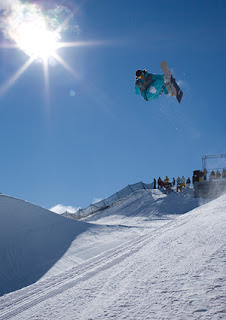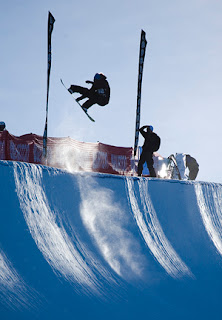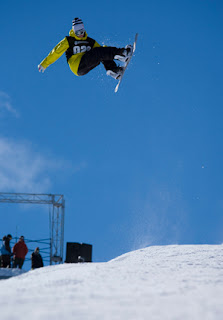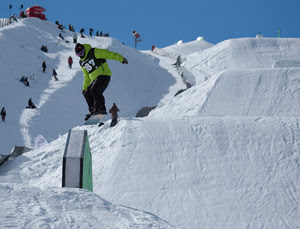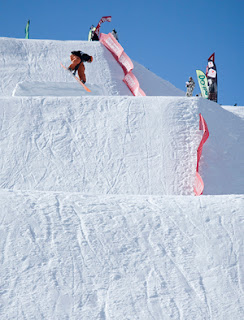There are so many good snowboards to choose from. The trick is to find the board that is best suited for you. Following are the top 5 things to take into consideration when shopping for a new snowboard.
Type of Snowboard - Freestyle, Freeride or Race
There are 3 main styles in snowboarding: freestyle, freeride and freecarve/race. In terms of numbers, snowboarders are pretty evenly split between freestyle and freeride, while race boards are more rare - you probably already know if you're in this category. Manufacturers design boards for each of these styles of riding, so it is good to have a basic understanding of where you fit before you shop.
 Snowboarding Styles
Snowboarding StylesIn the few decades that snowboarding has been around, a few distinct styles have emerged within the sport. These styles are characterized by their preferred terrain, their specific equipment and their own competitions.
It is important to know what type of snowboarder you are -- or are interested in becoming -- before you drop your savings on a new board/boots/bindings setup. Manufacturers carefully design boards for specific types of riding, and you don't want to make the mistake of buying a $450 big mountain board if you're going to spend all day in the pipe.
 Freestyle
FreestyleFreestyle riding is the flavor of the day. This style focuses on jumps, tricks, rail slides, halfpipes and switch riding.
Snowboard movies typically showcase freestyle riding; it is fun to watch and where pros can really show off their skills.
Many resorts design and maintain snowboard parks for freestyle riders with jumps, rails and halfpipes.
Freestyle equipment uses a soft boot and a relatively short, maneuverable board. A general freestyle board will be designed to handle well on jumps, spinning in the air and riding switch.
Many resorts design and maintain snowboard parks for freestyle riders with jumps, rails and halfpipes.
Freestyle equipment uses a soft boot and a relatively short, maneuverable board. A general freestyle board will be designed to handle well on jumps, spinning in the air and riding switch.
Some freestyle boards are designed specifically for the halfpipe alone or for the perfect rail slide. If you can afford a board for every occasion, these specialty boards will ride extremely well in the condition for which they were designed -- but are not likely to perform well outside of that specific terrain.
The most popular snowboarding events are freestyle competitions. These include halfpipe, quarterpipe, slopestyle and big air competitions.
Freeride
Whether just learning to link turns or pushing the limits of an Alaskan descent, freeriders prefer the all mountain experience: open terrain, backcountry chutes, fresh powder, trees -- as well as an afternoon spent in the park or in a freshly cut pipe. This is the realm where pros can show what they are really made of; it is a conversation between rider and mountain.
Freeriding is the most general style of snowboarding and has correspondingly versatile equipment. Like freestyle, freeride equipment uses a soft boot. Boards in this category are relatively longer and more directional in their shape. If you don't know what kind of terrain you like, or know that you like everything, this is your category.
Freecarve / Race
This often overlooked style of snowboarding focuses on carving and racing. Sometimes called alpine snowboarding, freecarving takes place on hard-pack or groomed runs and focuses on the ultimate carving turn. Little or no jumping takes place in this discipline.
Freecarve equipment is comprised of a hard boot and plate binding system, while the boards are stiff, narrow and relatively long.
Style of snowboarding includes competitions that are modeled after ski racing, such as the parallel giant slalom - an Olympic event in which racers maneuver around gates or poles.
Decisions, Decisions
you are just starting out, avoid highly specific equipment; i.e., boards that are only designed to perform well in one environment. As a new snowboarder, you will want to round out your skills on a variety of terrain without your gear holding you back. Beginners should look for a good all-around design, most likely a freeride or freestyle setup.
Your first season also, you will be able to discern if you want to specialize in one type of riding or another. You may decide that you can afford a couple different boards -- maybe a long freeride board for powder and a shorter freestyle board for days in the park. Just be sure to understand riding styles before you buy, then look for equipment that is well-suited to your needs.
The most popular snowboarding events are freestyle competitions. These include halfpipe, quarterpipe, slopestyle and big air competitions.
Freeride

Whether just learning to link turns or pushing the limits of an Alaskan descent, freeriders prefer the all mountain experience: open terrain, backcountry chutes, fresh powder, trees -- as well as an afternoon spent in the park or in a freshly cut pipe. This is the realm where pros can show what they are really made of; it is a conversation between rider and mountain.
Freeriding is the most general style of snowboarding and has correspondingly versatile equipment. Like freestyle, freeride equipment uses a soft boot. Boards in this category are relatively longer and more directional in their shape. If you don't know what kind of terrain you like, or know that you like everything, this is your category.
Freecarve / Race
This often overlooked style of snowboarding focuses on carving and racing. Sometimes called alpine snowboarding, freecarving takes place on hard-pack or groomed runs and focuses on the ultimate carving turn. Little or no jumping takes place in this discipline.
Freecarve equipment is comprised of a hard boot and plate binding system, while the boards are stiff, narrow and relatively long.
Style of snowboarding includes competitions that are modeled after ski racing, such as the parallel giant slalom - an Olympic event in which racers maneuver around gates or poles.
Decisions, Decisions
you are just starting out, avoid highly specific equipment; i.e., boards that are only designed to perform well in one environment. As a new snowboarder, you will want to round out your skills on a variety of terrain without your gear holding you back. Beginners should look for a good all-around design, most likely a freeride or freestyle setup.
Your first season also, you will be able to discern if you want to specialize in one type of riding or another. You may decide that you can afford a couple different boards -- maybe a long freeride board for powder and a shorter freestyle board for days in the park. Just be sure to understand riding styles before you buy, then look for equipment that is well-suited to your needs.



















